Decorating your Home with Chinese Tables
A Chinese style table is a great option for adding a touch of exotic flair to a contemporary space. Whether you are looking for a console table, coffee table, end table, or dining set, there are several styles with distinctive qualities to match your taste. The sheer range of options can be daunting when determining what piece is right for you and your situation, so we have compiled a comprehensive list of Chinese table designs to help you with your search.
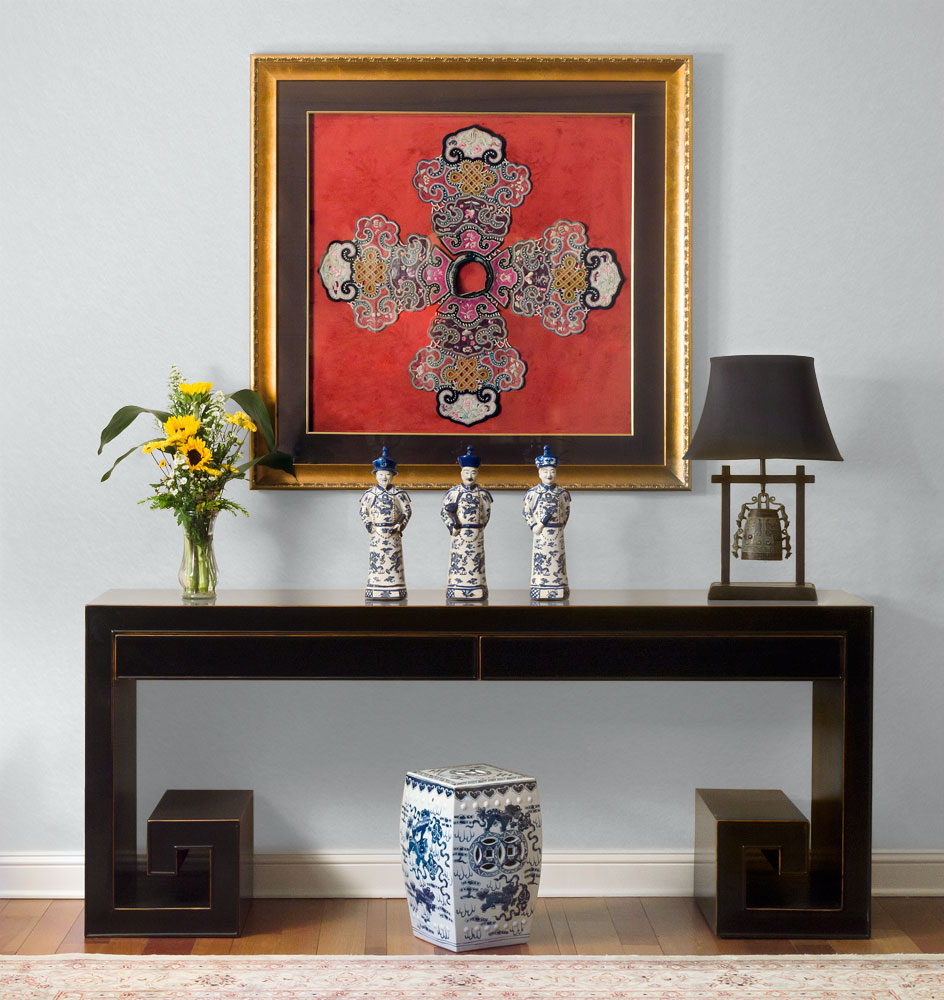
When placed against a wall, an Asian console table can be paired with plaques and art to make a grand statement or create a focal point in a space.
Chinese Console Tables
Typically featuring a very long and narrow surface, the minimal depth of a traditional Chinese console table makes it a great addition to an area of the home where space may be limited. Although there are many unique forms, the design of each table carries a certain intrigue tied to its historical function. Although today these tables are used primarily for decorating, they were originally used in China for a variety of roles like religious worship and rituals, unraveling and writing long scrolls, and also for holding large stringed instruments like the Guzheng.
One of the most recognizable forms, the Chinese altar table, also known as the Chinese calligraphy table, features wings that protrude outward and hang freely past the table legs. The altar style was frequently incorporated in Chinese praying table design, and the antique pieces can vary significantly in size with some being quite tall (to function as a worshipping altar). Appearance wise, they can range from elaborate, with extensive hand carved details, to more simple with little embellishment and clean simple geometry. The legs can be varied as well, with some being straight, some being adorned with horse hoof feet, and others being joined by horizontal beams or carved panels.
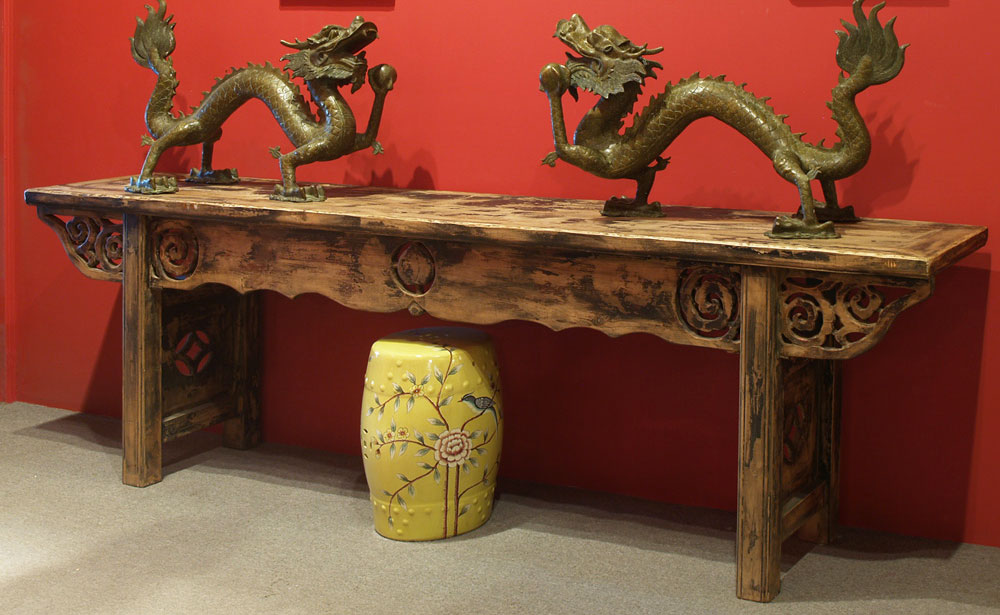
The look of traditional Chinese altar tables can vary greatly. Many are one of a kind with unique features like hand carved designs, but they all feature wings that extend past the table legs.
For those who are more price conscious, there are beautiful reproductions available that may not carry with them the rich history of their antique and vintage counterparts, but are no less striking. These more affordable replicas often feature a distressed finish to give them an aged and weathered appearance.
For a more modest and contemporary look, a smaller Chinese sofa table may be a more preferable option compared to an altar table. These types of tables also come in several varieties but unlike traditional altar style tables, they commonly feature metal hardware as well as storage compartments and drawers. Their compact size also makes them more practical for placement behind a floating couch or against a wall in a hallway or foyer.
There are others that do not feature any storage or metal fittings, and have a more simple design with solid wood construction and a flat matte or glossy lacquer finish. The lacquer option offers a bolder and more luxurious look. Multiple coats of either clear or colored lacquer produce a finish that is not only highly resistant to elements (and spills) but also gives the furniture a lustrous sheen.
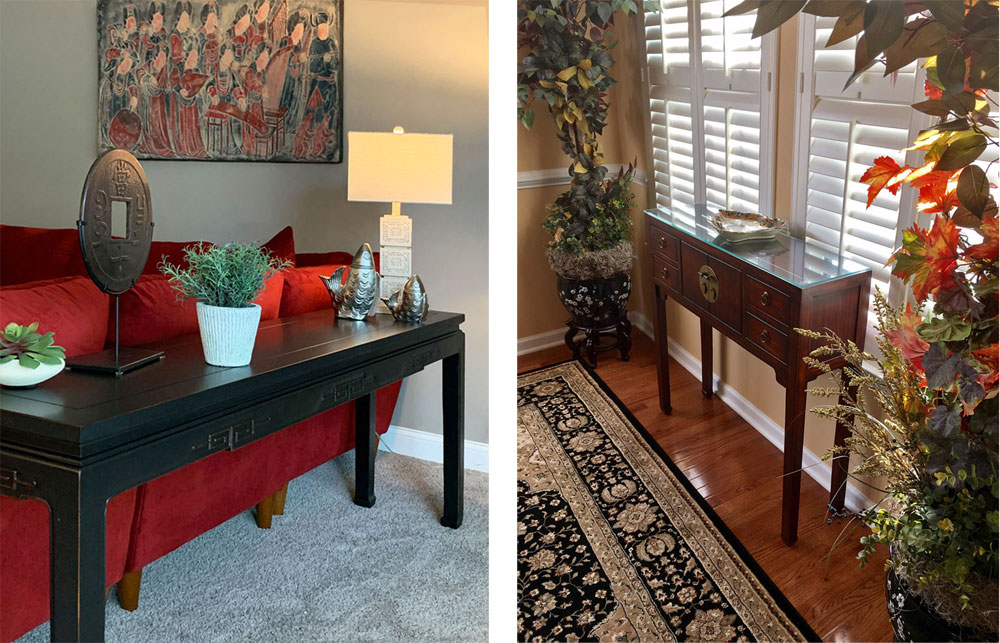
The narrow depth of a Chinese sofa table makes it a great accent that does not take up much space in a room. Featured left: a black matte finish sofa table with Chinese cloud carvings. Featured right: a Ming style console table with polished brass hardware.
If you prefer your sofa table to have options for storage, the Ming style is very popular for its minimalist design, simple clean lines, and iconic circle plate hardware. Although the design and craft techniques of Ming style furniture originated several hundred years ago, these pieces have a timeless aesthetic that has made them popular in homes throughout the world to this day.
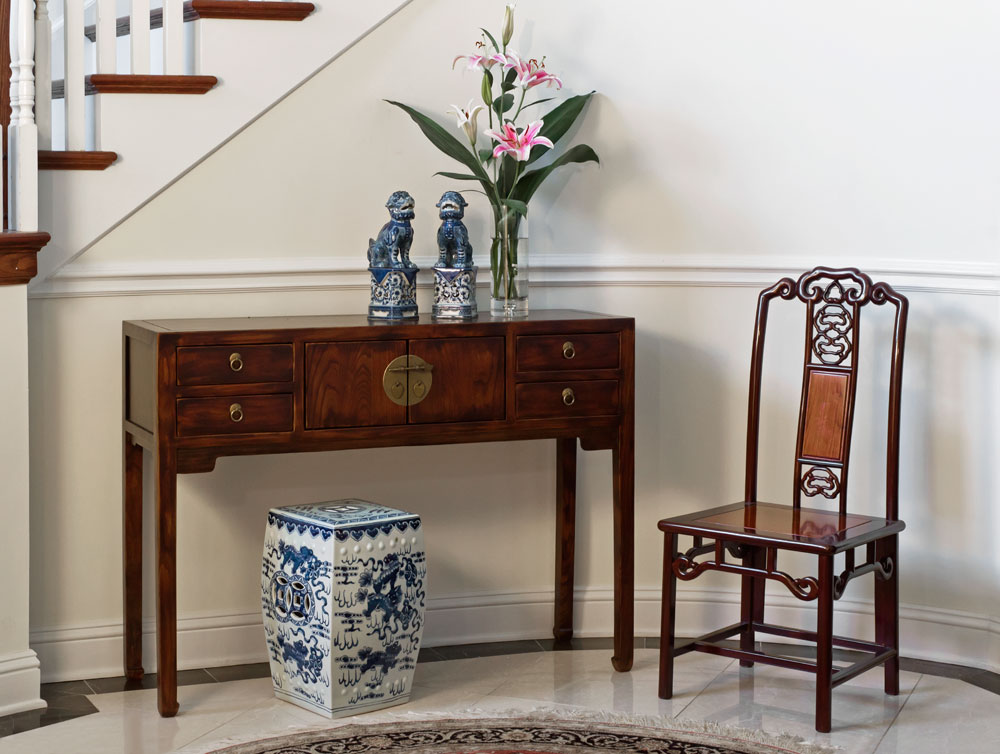
A classic Ming style console table with dark mahogany wood stain.
Chinese Coffee Tables
Today’s Chinese style furniture that fits the profile of a typical coffee table actually evolved from the design of the Chinese Kang table. The kang tables that influenced the design of the oriental tea tables and coffee tables we see today originated in China during the Ming dynasty (1368-1644) when they were generally used as benches or chair level beds.
During the 17th and 18th centuries when tea and coffee tables would become a household item throughout the western world, the low height of the kang table made its design ideal for appropriation as a surface for beverages in the living room or in front of a sofa. This unique historical perspective is important because the aesthetic features seen in these early Ming era kang tables are still commonly used in Asian table designs to this day. This is a testament to the timeless qualities and craft of these earlier tables.

The wide ranging unique design features of antique kang tables like these still provide inspiration for contemporary Asian coffee tables today.
There are many unique options in style, shape, and size when choosing a Chinese coffee table. A popular selection is the Chinese chow table, a coffee table that features legs that curve outward and often end in a horse hoof shaped foot. This type of table can also be found with different subtle hints of character or embellishments. For example, some have a center surface with open carving geometric patterns that are topped with glass. Others have a solid wood top but have elegant carvings on the apron or legs. Less elaborate designs are also prevalent, and these forego carvings or other intricate details for a solid matte or lacquer finish.
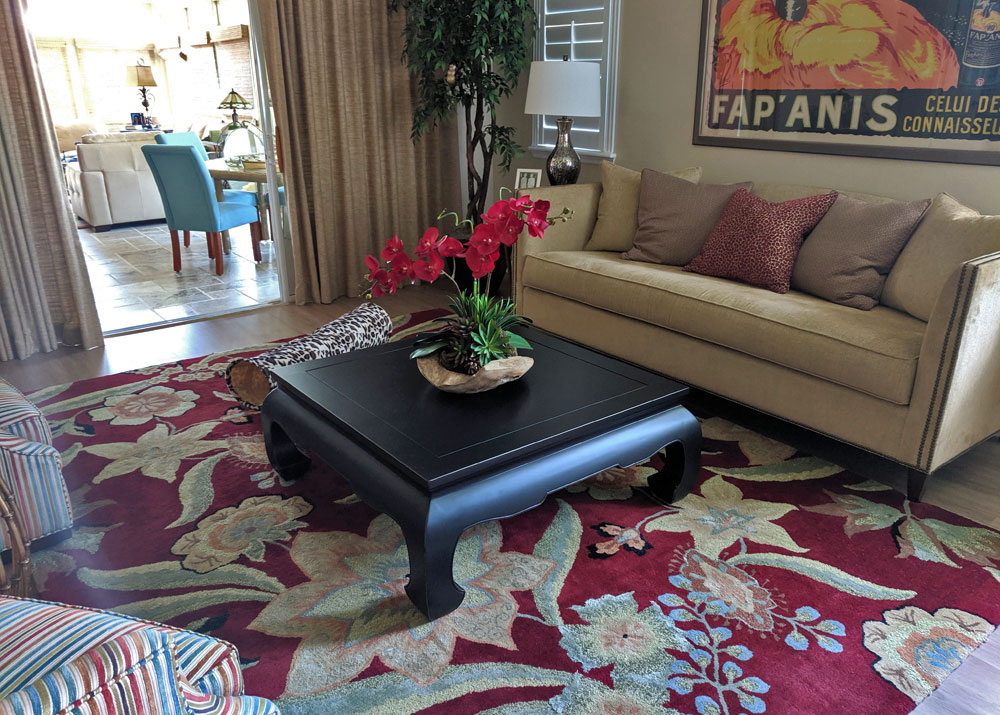
A Chinese chow coffee table with solid matte black finish and horse hoof feet.
Another option with a form that is quite distinct from the chow table is the Chinese scroll table. As the name suggests, this table mimics a scroll with the top surface organically curving outward and curling inwards to form the legs of the table. This form of table developed during the Ming Dynasty with the rise of the scholar class in China, where it would be an important part of the scholar's studio. These individuals were often court officials whose entire lives were dedicated to the pursuit of knowledge and were highly trained in many subjects like philosophy, law, music, agriculture, and calligraphy.
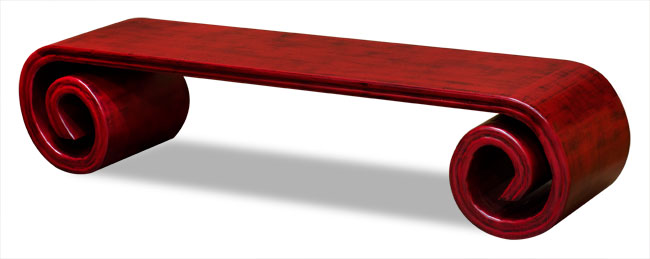
A chinese scroll table with red distressed finish
Chinese Side Tables and Nesting Tables
Aside from their more compact size, many smaller Chinese tables are influenced by the same design features seen in coffee tables. Similar to how Chinese coffee tables evolved from a type of table (Kang) originally intended for sitting or laying, Chinese side tables evolved from tall square stools, which were originally intended for use as a single person seat. The taller height of these stools, along with their smaller top surface area, made them perfect for appropriation as a side table for drinks, lamps or books alongside a sofa or chair.
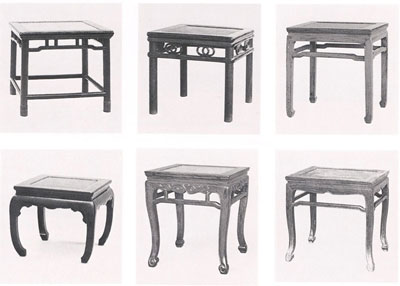
Traditional Chinese stools like these are today used as side tables
Nesting tables are a very unique subcategory among side tables and are totally separate from typical Chinese side tables. A nesting table set is an assorted matching set of tables that vary in size from smaller to larger. Unlike traditional Chinese side tables whose designs are influenced by stools crafted during the Ming dynasty, the design of nesting tables originated in 18th century Europe. These can serve the same function as a normal side table, but with a unique cascading effect that also grants greater surface area. It is an excellent choice for those that are interested in a more flexible and functional option.
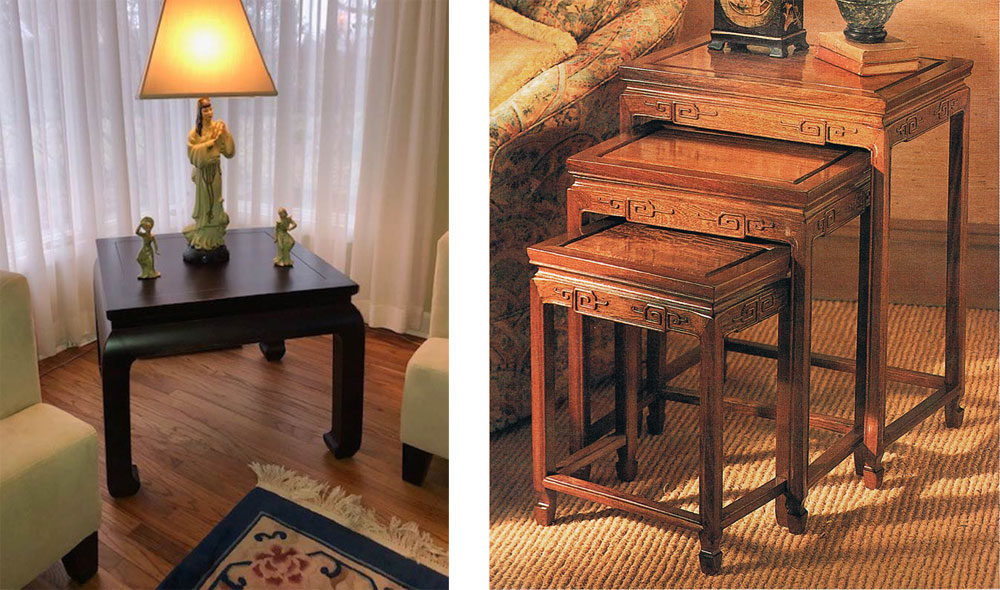
Left: A ming style end table. Right: Rosewood nesting tables with a natural clear coat finish and carved Chinese key design
Chinese Dining Tables
Although rectangular sets are common, the round Chinese dinner table is a more traditional option. In terms of eating customs, the circular shape is preferred in China as it makes sharing dishes between individuals during meal time much more convenient. These circular tables often come with a lazy susan, making the passing of food even easier.
When it comes to materials and craftsmanship, a traditional Chinese dining set is second to none and would serve as a magnificent showpiece in any dining room. Often made from solid hardwoods, these sets combine delicate and elaborate carving work with joinery techniques that ensure long lasting durability. Of the hardwood sets, those made of rosewood are by far the most sought after. For centuries, rosewood has been the lumber of choice of Chinese carpenters for its complex and varied wood grains, natural floral aroma, and high density. These days, many types of rosewood are a rare commodity, so the price of furniture made from this material is always on the rise.
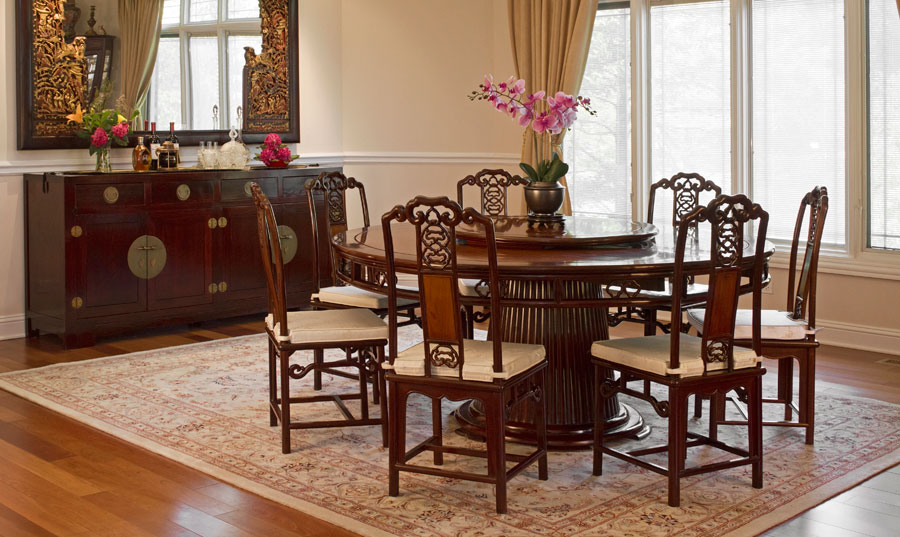
A traditional hand carved rosewood dining set
Another popular style of Chinese dining set is the black lacquer design. These sets have a completely different aesthetic than the rosewood dining table, but are no less striking. Coated with multiple layers of glossy lacquer, they often feature elaborate hand painted details like flowers and vines. Additionally they commonly have carved mother of pearl figurines that adorn the table surface and back rest of each chair.
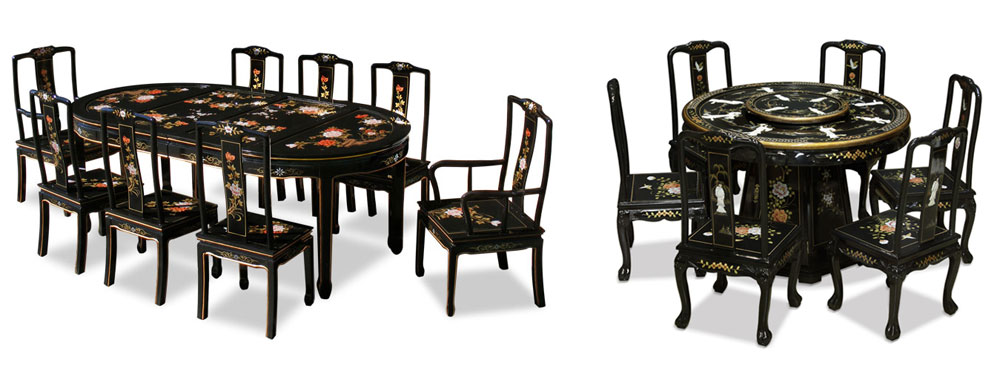
Chinese black lacquer dining sets embellished with hand painted art work
Hopefully this article on Chinese table designs helped broaden your view of the options available for your decorating purposes. And if it did, be sure to check out some of our other articles to further assist your interior design projects!


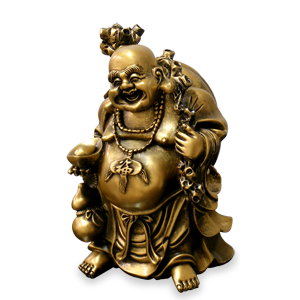
SocialMedia